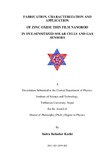Please use this identifier to cite or link to this item:
http://archive.nnl.gov.np:8080/handle/123456789/248| Title: | Fabrication, characterization and application of zinc oxide thin film nanorod in dye-sensitized solar cells and gas sensors |
| Authors: | Karki, Indra Bahadur |
| Keywords: | Zinc oxide ZnO nanorods Dye Sensitized Solar Cells Orthodox Tea Tea Aroma |
| Issue Date: | 5-Dec-2017 |
| Abstract: | Multifunctional zinc oxide (ZnO) semiconductor is a potential candidate for electronics and optoelectronics applications and can be utilized commercially due to its availability, chemical stability and other excellent electrical and optical properties. The semiconducting and piezoelectric properties of environmental friendly ZnO are extremely useful for designing new kind of energy harvesting devices. As a part of this PhD work, an extensive research were performed on ZnO based materials, both as nano powders and thin films that relates specifically to ZnO nanostructure based electrochemical sensors and Dye-Sensitized Solar Cells (DSSCs) applications. The research focused on the synthesis and characterization of zinc oxide thin films. The thin films were prepared using sol-gel spin coating method (thin film deposition) while the structural characterization of the films was performed by X-ray diffraction and the morphology was evaluated by SEM Microscopy. The electrical properties of the ZnO thin films based DSSCs were determined by Keithley 2400 digital multimeter and absorption spectra of natural dyes were determined through UV-VIS spectroscopy. One of the main objectives of this experimental research work is to study alternative locally available low-cost natural dye for DSSCs. In comparison to the more common Anthocyanin and Xanthene type natural dyes extracted from fruit extracts was also investigated. Following the recent developments in low cost materials and techniques for electrochemical solar cells using natural dyes and its properties and application based on the ZnO nanorod structures, the influence of various preparation parameters: dyes, temperature we have investigated and I-V characteristics of DSSCs were investigated. The characterization of the obtained ZnO nanostructures has been performed by using X-ray diffraction, SEM. Another main objective of this research work is to analyze sensing behaviour of zinc oxide nanorod substrate as a resistive sensor for Volatile Organic Components (VOC). The application of fabricated devices was successfully demonstrated as chemical sensors for the detection of tea aroma using potentiometric technique. The sensor devices fabricated and characterized in the work were used to detect tea aroma of Darjeeling Orthodox and Assam, India, CTC tea. ZnO nanorod layers doped with various dopants were characterized individually for application as sensing element and finally, these sensors were assembled in the form of an electronic nose (E-nose). This e-nose assembly was tested for detection of tea aroma. Tea aroma is the resultant of various organic volatile molecules, which determine the quality of tea. Finally, a standardized device was fabricated for determining quality of tea based upon its aroma. |
| Description: | A dissertation submitted to the Central Department of Physics, Institute of Science and Technology, Tribhuvan University, Nepal for the Award of Doctor of Philosophy (Ph.D.) Degree in Physics, 2013. |
| URI: | http://103.69.125.248:8080/xmlui/handle/123456789/248 |
| Appears in Collections: | 500 Natural sciences and mathematics |
Files in This Item:
| File | Description | Size | Format | |
|---|---|---|---|---|
| PhD Thesis - Indra KARKI_final.pdf | 1.75 MB | Adobe PDF |  View/Open |
Items in DSpace are protected by copyright, with all rights reserved, unless otherwise indicated.